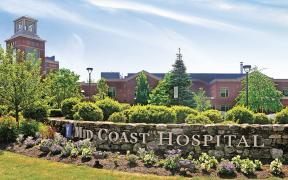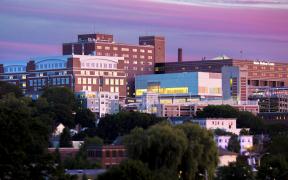It’s not unusual to have breast changes that include breast pain, breast tenderness and breast lumpiness. MaineHealth is here to help.
What are fibrocystic breasts?
Fibrocystic breasts have tissue that feels lumpy. Some people feel breast pain and breast tenderness. It is not unusual to have fibrocystic breasts. These breast changes are considered normal. Fibrocystic breasts are not cancerous. The discomfort of having fibrocystic breast usually goes away on its own. Breast changes also can be a sign of serious breast problems, including breast cancer.
Symptoms of fibrocystic breasts
Fibrocystic breast changes most often happen between the ages of 20 and 50. People often have fibrocystic breast symptoms before they have their period. Common fibrocystic breast symptoms include:
- Breast lumps and breast thickening
- Breast pain
- Breast tenderness
- Breast changes in both breasts
- Monthly breast changes
See a doctor if you have the following breast symptoms:
- Specific breast changes, including a breast lump, do not go away and seem to get worse
- There is a new breast lump or thickening area
- Breast changes continue after your period or your menstrual cycle ends
- Breast lump your doctor examined is getting bigger
Latest mammogram technology
Diagnosing and evaluating fibrocystic breasts
You may need to have a clinical breast exam and a mammogram to diagnose fibrocystic breasts and to rule out more serious breast problems, such as breast cancer. Early diagnosis is important to treating breast cancer.
The following tests may be used to evaluate your problem:
-
Clinical breast exam: Your doctor manually (by hand) checks your breasts and lymph nodes under your arms and in your lower neck.
-
Mammogram: An X-ray picture is taken of your breast tissue.
-
Ultrasound: Using sound waves, an ultrasound makes images of your breasts.
-
Fine-needle aspiration: For breast lumps, your doctor may use a needle to see if fluid can be removed. Fluid-filled sacs are called cysts.
-
Breast biopsy: When your doctor has concerns about a breast lump, a breast biopsy may be done. Patients may be referred to a surgeon for a breast biopsy. A small amount of breast tissue is removed for analysis.
Fibrocystic breasts: Is treatment needed?
If women are having few symptoms or no symptoms, no treatment is needed for fibrocystic breasts. The breast problems will go away. When a woman is having a lot of pain or has painful cysts from fibrocystic breasts, a doctor may advise her to have treatment. Treatment can include:
-
Fine-needle aspiration: Your doctor uses a very thin needle to take out the fluid from the cyst. The breast cyst goes away.
-
Surgery: If a cyst-like lump does not go away, your doctor may recommend surgery.

































